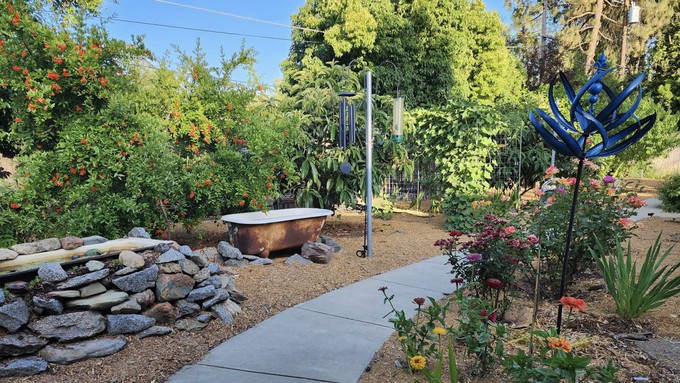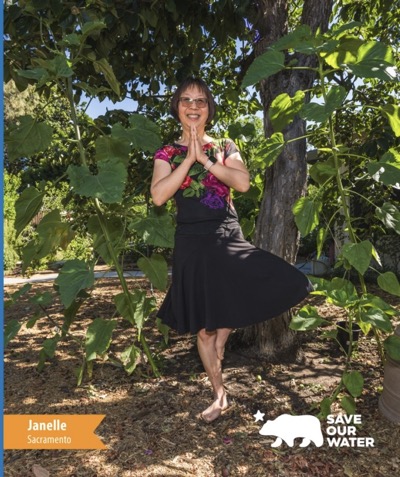
'Summer Strong Yard’ winner featured on local billboards in new awareness campaign

Janelle Auyeung, a master gardener who lives in Sacramento's Arden Park, created this water-wise garden over several years. Courtesy Janelle Auyeung
These billboards are hard to miss – and that’s the point.
Now starring on billboards throughout the Sacramento region, local residents with a knack for gardening while saving water are being saluted for their outstanding “Summer Strong Yards.” They’re the winners of a recent contest held by the Regional Water Authority and local water providers.
“Summer Strong Yards incorporate water-wise practices and efficient irrigation, making them tough enough to thrive during the Sacramento region’s hottest days while still looking great,” say the organizers. “Our honorees transformed their landscapes by ditching water-intensive lawns for vibrant, low-water native plants and smart drip irrigation systems. From Auburn to Elk Grove, their projects vary from DIY efforts to professionally designed masterpieces.”
Find all the winners here: https://bewatersmart.info/summer-strong-yard-winners/.
Among the winners was Sacramento’s Janelle Auyeung, whose garden truly is inspirational.

Waste not, want not; that philosophy underlines her creative approach to gardening. The result is a suburban oasis full of life – and food – to nourish the body as well as the soul.
“Over the past two decades, my garden has transformed from a typical lawn into a thriving ecosystem, driven by a vision of sustainability and resilience,” says Auyeung, who lives in Arden Park. “That’s what I’m passionate about – more sustainable living.”
Originally, her yard was a “plain old lawn,” devoid of biodiversity, she says. Little by little, she transformed it into her food- and flower-filled “Summer Strong Yard.”
Auyeung grew up in China, where her family produced much of its own food. “I learned to use resources sparingly,” she recalls.
Auyeung works as a scientist at the California Air Resources Board on climate issues, and has been in the environmental protection field for more than two decades, working on various initiatives. She has made sustainability her life focus and takes that same approach to her Sacramento landscape, which she has been working on for more than 20 years.
Kitchen waste becomes compost to feed her 30 fruit trees, abundant vegetable garden and thriving native plants. Homemade mulch retains moisture and keeps roots comfortable. She also “harvests” rainwater from a capture system attached to her home’s roof gutters and downspouts.
“When it rains, I can capture 3,000 gallons off the roof,” she says. “I use rainwater to brew compost tea. I put the compost tea into the drip irrigation system and it goes directly into the garden.”
Auyeung is both a Sacramento County master gardener and master food preserver. “I grow so much stuff, I had to learn how to preserve it,” she says.
With only a .3-acre lot, the yield from her bountiful garden is phenomenal. “Last year, I harvested more than 100 pounds of tomatoes,” she says. “I picked 200 pounds of persimmons. I have five kinds of citrus plus loquats, apricots, pomegranates; so much fruit.”
All while saving time and water, she says. “Once established, fruit trees don’t need too much work and there’s plenty to share with neighbors and co-workers.”
Besides edible plants, Auyeung concentrated on adding California natives as well as drought- and heat-tolerant flowering plants to attract pollinators.
“My garden is alive with so many beneficial insects,” she says. “Birds visit more often and stay longer. There’s so much biodiversity.
“Sustainability has become a way of life,” she adds. “My garden stands as a testament to what can be achieved with dedication, knowledge, and respect for the natural world.”
For more water-saving ideas and links to rebates, go to: https://bewatersmart.info/.
Comments
0 comments have been posted.Sacramento Digs Gardening to your inbox.
Food in My Back Yard Series
May 6: Maintain soil moisture with mulch for garden success
April 29: What's (already) wrong with my tomato plants?
April 22: Should you stock up on fertilizer? (Yes!)
April 15: Grow culinary herbs in containers
April 8: When to plant summer vegetables
April 1: Don't be fooled by these garden myths
March 25: Fertilizer tips: How to 'feed' your vegetables for healthy growth
March 18: Time to give vegetable seedlings some more space
March 11: Ways to win the fight against weeds
March 4: Potatoes from the garden
Feb. 25: Plant a fruit tree now -- for later
Feb. 18: How to squeeze more food into less space
Feb. 11: When to plant? Consider staggering your transplants
Feb. 4: Starting in seed starting
Sites We Like
Garden Checklist for week of May 11
Make the most of the lower temperatures early in the week. We’ll be back in the 80s by Thursday.
* Plant, plant, plant! It’s prime planting season in the Sacramento area. Time to set out those tomato transplants along with peppers and eggplants. Pinch off any flowers on new transplants to make them concentrate on establishing roots instead of setting premature fruit.
* Direct-seed melons, cucumbers, summer squash, corn, radishes, pumpkins and annual herbs such as basil.
* Harvest cabbage, lettuce, peas and green onions.
* In the flower garden, direct-seed sunflowers, cosmos, salvia, zinnias, marigolds, celosia and asters. (You also can transplant seedlings for many of the same flowers.)
* Plant dahlia tubers.
* Transplant petunias, marigolds and perennial flowers such as astilbe, columbine, coneflowers, coreopsis, dahlias, rudbeckia and verbena.
* Keep an eye out for slugs, snails, earwigs and aphids that want to dine on tender new growth.
* Feed summer bloomers with a balanced fertilizer.
* For continued bloom, cut off spent flowers on roses as well as other flowering plants.
* Add mulch to the garden to maintain moisture. Mulch also cuts down on weeds. But don’t let it mound around the stems or trunks of trees or shrubs. Leave about a 6-inch-to-1-foot circle to avoid crown rot or other problems.
* Remember to weed! Pull those nasties before they set seed.
* Water early in the day and keep seedlings evenly moist.